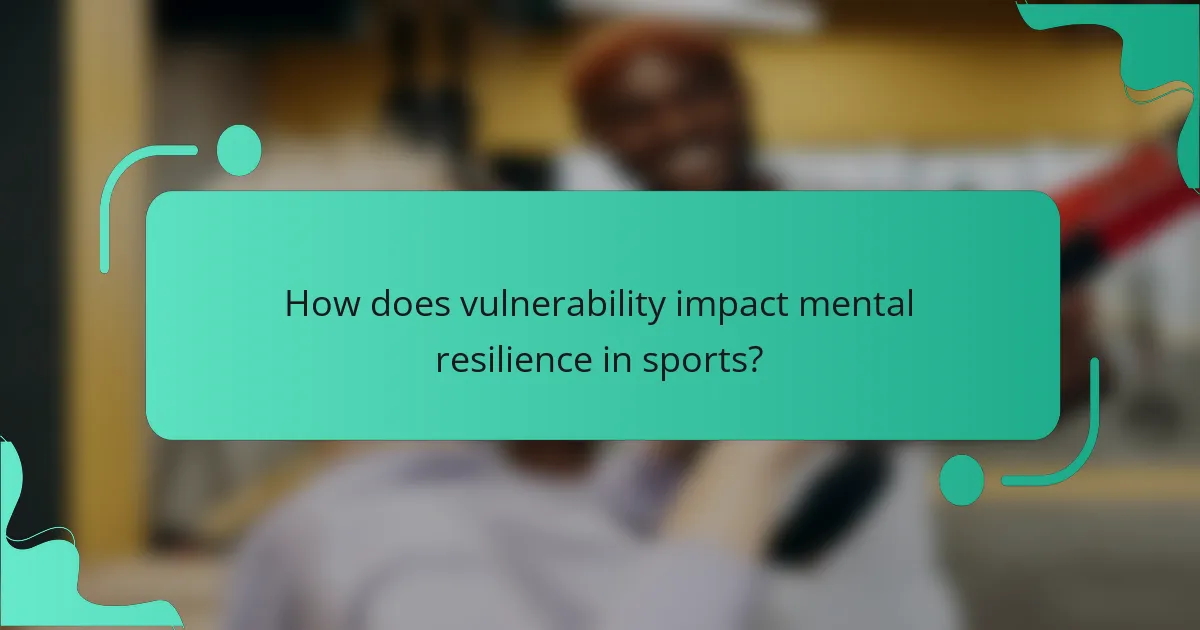Embracing vulnerability in sports can significantly enhance mental resilience and team dynamics. This approach fosters open communication and emotional transparency, leading to improved performance. Athletes can strengthen their connections by sharing personal challenges and seeking feedback. By creating a supportive environment, teams can boost collaboration and overall success.

How does vulnerability impact mental resilience in sports?
Vulnerability enhances mental resilience in sports by fostering authenticity and connection. Athletes who embrace vulnerability build trust within teams, leading to improved communication and collaboration. This openness allows for better emotional regulation, helping athletes manage stress and setbacks. Research shows that teams with high vulnerability levels experience increased performance and cohesion, creating a supportive environment conducive to growth.
What are the psychological benefits of embracing vulnerability?
Embracing vulnerability in sports fosters psychological benefits such as increased mental resilience, improved performance, and enhanced team dynamics. Acknowledging weaknesses allows athletes to build trust, leading to better communication and collaboration. This openness encourages a growth mindset, where mistakes become learning opportunities. As a result, teams that embrace vulnerability often experience higher levels of cohesion and support, essential for achieving collective goals.
How can self-talk enhance emotional strength during competitions?
Self-talk can significantly enhance emotional strength during competitions by fostering a positive mindset. It helps athletes manage anxiety, focus on goals, and boost confidence. Research shows that self-affirmation through positive self-talk can lead to improved performance outcomes. Athletes who engage in constructive self-dialogue often exhibit greater resilience, allowing them to navigate challenges effectively. Consequently, integrating self-talk strategies into training can strengthen mental resilience, ultimately benefiting performance and team dynamics.
What techniques improve self-talk for athletes?
Athletes can improve self-talk through techniques such as positive affirmations, visualization, and mindfulness. Positive affirmations reinforce confidence and focus on strengths. Visualization helps athletes mentally rehearse successful performances, enhancing belief in their abilities. Mindfulness practices increase awareness of negative self-talk, allowing athletes to reframe thoughts constructively. Engaging in these techniques fosters mental resilience, ultimately boosting performance and enhancing team dynamics.
How can athletes identify negative inner dialogue?
Athletes can identify negative inner dialogue by recognizing self-critical thoughts and patterns. They should monitor their internal monologue during training and competition. Journaling or discussing feelings with teammates can reveal recurring negative themes. Mindfulness practices help in acknowledging these thoughts without judgment, fostering awareness and resilience.
What role does vulnerability play in team dynamics?
Vulnerability fosters trust and openness in team dynamics, enhancing collaboration and performance. When team members share their struggles, it encourages a supportive environment, leading to increased mental resilience. This openness allows teams to adapt and innovate, ultimately boosting overall performance. Embracing vulnerability can transform team interactions, making them more effective and cohesive.
How can open communication foster trust among teammates?
Open communication fosters trust among teammates by creating an environment where individuals feel safe to express their thoughts and concerns. This transparency encourages collaboration and strengthens team dynamics. When teammates share vulnerabilities, they build deeper connections, enhancing mental resilience and overall performance. As a result, teams become more cohesive, leading to improved outcomes in sports.

What unique strategies can athletes use to embrace vulnerability?
Athletes can embrace vulnerability by fostering open communication, sharing personal challenges, and seeking feedback. These strategies enhance mental resilience, improve performance, and strengthen team dynamics. Engaging in self-reflection allows athletes to understand their emotions, leading to greater authenticity. Additionally, creating a supportive environment encourages team members to express vulnerability without fear of judgment. Embracing vulnerability ultimately builds trust and camaraderie among athletes, enhancing overall performance.
How can storytelling improve self-awareness and performance?
Storytelling enhances self-awareness and performance by allowing athletes to connect emotionally with their experiences. It fosters vulnerability, which strengthens mental resilience and promotes personal growth. By sharing narratives, athletes gain insights into their strengths and weaknesses, improving team dynamics and overall performance.
What types of personal stories resonate most with athletes?
Personal stories that resonate most with athletes include experiences of overcoming adversity, sharing struggles with mental health, and moments of vulnerability. These narratives foster connection, encourage openness, and enhance team dynamics, ultimately strengthening mental resilience and boosting performance. Athletes often relate to tales of perseverance, highlighting the human aspect of sports that transcends competition.
What are the unique challenges of vulnerability in competitive settings?
Vulnerability in competitive settings often leads to fear of judgment and performance anxiety. Athletes may struggle to show weakness, impacting their mental resilience. Embracing vulnerability can enhance team dynamics by fostering trust and open communication. This shift allows athletes to learn from failures, ultimately boosting performance.
How can athletes navigate fear of judgment from peers?
Athletes can navigate fear of judgment by embracing vulnerability, fostering a supportive environment, and focusing on personal growth. Acknowledging feelings of fear allows athletes to confront and process them, enhancing mental resilience. Building strong team dynamics through open communication cultivates trust, reducing the impact of judgment. Additionally, focusing on individual performance and progress shifts attention away from external opinions, promoting a healthier mindset.

What are the rare attributes of vulnerability in sports?
Embracing vulnerability in sports involves recognizing unique attributes that can enhance mental resilience and team dynamics. Rare attributes include emotional transparency, which fosters trust among teammates; adaptive risk-taking, encouraging athletes to step outside their comfort zones; and authentic self-expression, allowing individuals to showcase their true selves. These attributes create a supportive environment that ultimately boosts performance.
How can vulnerability lead to breakthrough performances?
Vulnerability can lead to breakthrough performances by fostering mental resilience and enhancing team dynamics. Embracing vulnerability allows athletes to confront fears, leading to personal growth and improved performance. This openness cultivates trust within teams, encouraging collaboration and communication. As a result, teams that embrace vulnerability often experience greater cohesion and collective success.
What examples exist of athletes who thrived through vulnerability?
Several athletes have thrived through vulnerability, showcasing its power in sports. Michael Phelps openly discussed his mental health struggles, using vulnerability to inspire others and enhance team dynamics. Simone Biles prioritized her mental well-being during the Tokyo Olympics, demonstrating that acknowledging vulnerability can lead to stronger performance. Kevin Love shared his journey with anxiety, advocating for mental health awareness in sports. These examples illustrate how embracing vulnerability can strengthen mental resilience and improve overall performance.
What common mistakes do athletes make when trying to embrace vulnerability?
Athletes often make mistakes by avoiding vulnerability, misinterpreting it as weakness. They may fear judgment from teammates or coaches, leading to a lack of openness. Additionally, some athletes struggle to express emotions, believing it undermines their competitive edge. This can hinder mental resilience and team dynamics, ultimately affecting performance. Embracing vulnerability is crucial for growth and connection in sports.

How can athletes apply best practices for embracing vulnerability?
Athletes can embrace vulnerability by sharing their struggles and seeking support. This openness fosters mental resilience, improves performance, and strengthens team dynamics. By acknowledging weaknesses, athletes create trust and deeper connections within the team. Engaging in vulnerability can lead to enhanced collaboration and a more cohesive environment, ultimately boosting overall success in sports.
What actionable steps can enhance mental resilience through vulnerability?
Embracing vulnerability enhances mental resilience by fostering authentic connections and encouraging personal growth. To implement actionable steps, athletes can start by sharing their fears and challenges with teammates, creating a supportive environment. Regular reflection on experiences can help individuals recognize their strengths and weaknesses, promoting self-awareness. Participating in team-building exercises fosters trust and open communication, essential for collective resilience. Finally, setting realistic goals encourages athletes to embrace setbacks as learning opportunities, reinforcing a growth mindset.
How can athletes create a supportive environment for sharing vulnerabilities?
Athletes can create a supportive environment for sharing vulnerabilities by fostering open communication and trust. Establish regular team meetings to encourage discussions on mental health and personal challenges. Promote active listening and empathy among teammates to enhance emotional support. Implement peer mentorship programs where experienced athletes guide others in sharing their experiences. Encourage vulnerability as a strength, emphasizing its role in building resilience and team cohesion.
What role do coaches play in fostering vulnerability among athletes?
Coaches play a crucial role in fostering vulnerability among athletes by creating a safe environment for open communication. This supportive atmosphere encourages athletes to express their fears and uncertainties, which enhances mental resilience. Coaches can model vulnerability themselves, showing that it is a strength rather than a weakness. As a result, athletes feel more connected to their teammates, improving overall team dynamics and performance. This approach promotes trust and collaboration, essential elements for success in sports.
